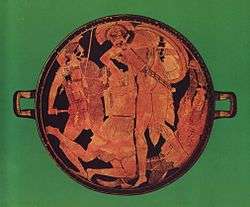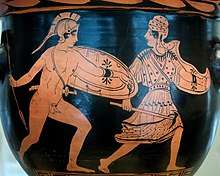Penthesilea
Penthesilea (Greek: Πενθεσίλεια, Penthesileia) was an Amazonian queen in Greek mythology, the daughter of Ares and Otrera and the sister of Hippolyta, Antiope and Melanippe. She assisted Troy in the Trojan War, during which she was killed by Achilles.

In the Epic Cycle
In the five book epic Aethiopis, which was part of the Epic Cycle (or Cycle of Troy) on the Trojan War, the coming to Troy of Penthesilea and Memnon was described in detail.[1] The Aethiopis was published in the 8th century BC and is attributed to Arctinus of Miletus. The main character of the epic is Achilles, who fights Penthesilea and Memnon before he is himself killed. Although Aethiopis has been lost, the Epic Cycle has been adapted and recycled in different periods of the classical age. The tradition of retelling the epic fall of Troy is indebted to Homer's Iliad and Odyssey, which were grounded in oral story-telling and were only written down when the Greek alphabet was adopted in ancient Greece.[2]
In the Aethiopis Penthesilea is a Thracian woman warrior. She was an Amazon and daughter of Ares, who comes to help the Trojans. She arrived with twelve other Amazon warriors. After a day of distinguishing herself on the battle-field, Penthesilea confronts Achilles. Achilles kills her, but after taking off her helmet, he falls in love with her.[3] Thersites rebukes Achilles for having fallen in love. Thersites is killed by Achilles, who travels to the island of Lesbos to be purified before returning to Troy and fighting Memnon.[4]
According to Homer, the Trojan king Priam had fought the Amazons in his youth on the Sangarius River in Phrygia, some 350 miles east of Troy. Later writers of the antiquity located Amazons geographically in Anatolia and started an epic tradition where Greek heroes, such as Heracles and Theseus, fought an Amazon warrior of distinction.[5] The Aethiopis version of the Penthesilea legend has become known as the Homeric tradition.[6]
Other traditions
Different traditions of the Penthesilea legend appear to have existed in the time the Epic Cycle was published. In a lost poem of Stesichorus, believed to have been published in the 7th or 6th century, Penthesilea rather than Achilles had killed Hector.[7]
Temple of Apollo Epicurius at Bassae
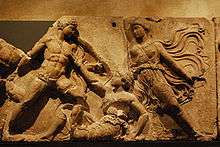
At the Temple of Apollo Epicurius, built in the mid- to late-5th century BC, scenes from the Trojan War are preserved in the Bassae Frieze, a high relief marble sculpture in 23 panels. Here the Greek army is charged by the Amazons, who gain the upper hand, and at the height of the battle Achilles slays Penthesilea on a slab known as BM 537. Achilles and Penthesilea are flanked by a Greek soldier and an Amazon. Penthesilea is identified as a queen by a crown. Penthesilea, shown on the ground just before being struck, and Achilles are exchanging a gaze.[8] The final slab of the series on the Amazons depicts a truce between the Greek army and the Amazons at the end of the battle.[9]
Temple of Zeus at Olympia
According to Pausanias, the throne of Zeus at Olympia bore a painting by Panaenus of the dying Penthesilea being supported by Achilles. Pausanias wrote "And, at the extremity of the painting, is Penthesilea breathing her last, and Achilles supporting her".[10] The motive of Achilles supporting a dying or dead Penthesilea has been preserved at the Temple of Aphrodisias and was reinterpreted in sculptures and mosaics in ancient Rome.[11]
As vase motif
A black figure vase from about 510–500 BC shows Achilles carrying Penthesilea from the battlefield.[12]
The subject of Penthesilea was treated so regularly by the so called Penthesilea Painter, who was active between 470 and 450 BC, that Adolf Furtwängler dubbed him "The Penthesilea Painter". A considerable corpus for this innovative and prolific painter, whose work bridged the "Severe style" and Classicism and must have had a workshop of his own, was rapidly assembled[13] in part by J.D. Beazley.
In the Bibliotheke
In the Pseudo-Apollodorus Epitome of the Bibliotheke[14] she is said to have been killed by Achilles, "who fell in love with the Amazon after her death and slew Thersites for jeering at him".
Lycophron on Penthesilea
In the 3rd century BC Lycophron went against the grain of the Homeric tradition. The poet had been born in Euboea, the site of a shrine to wounded Amazons who had fought in a mythic Battle for Athens. Lycophron tells the story of the young Amazon Clete, Penthesilea's attendant, who had been left behind in Pontus. Clete sets out with a company of Amazons to search for Penthesilea when she does not return from the Trojan War. The ship with Amazons is swept of course and after a shipwreck on the toe of Italy in Bruttium, Clete becomes the queen of the Amazons that settle there.[15]
In Virgil's Aeneid
In Virgil's Aeneid, written between 29 and 19 BC,[16] the Trojan army falls back when Achilles advances. Achilles drags the greatest Trojan warrior Hector around the city walls and sells his dead body to king Priam for gold. Penthesilea is cast as a tragic Amazon queen who came too late in vain to help the beleaguered city. When Aeneas sees the panel of Penthesilea in the Juno temple of Carthage,[17] he knows that the defeat of Penthesilea and Memnon presage a chain of events that would culminate in the sacking of the city. Penthesilea's fate also foreshadows that of Camilla, which is described in detail by Virgil later in the epic.[18] According to Virgil, Penthesilea led an army of Amazons and is a bellatrix (Latin for "female warrior") who dared to fight men (audetque viris concurrere virgo).[19]
Virgil based his narrative in Homer's Iliad, while relying on the Epic Cycle for his portrayal of Penthesilea.[20] Virgil also reworked oral legends into an epic on the foundation of Rome. In Aeneid the Romans descended from the hero Aeneas and Trojan refugees who sailed to Italy after the Trojan War. This interweaving of the Penthesilea legend with the founding legend of Rome can be traced to Lycophron.[21]
In Diodorus' Bibliotheca
In his universal history Bibliotheca historica Diodorus Siculus in the 1st century BC celebrated Penthesilea as the last Amazon to win renown for valour in war. Diodorus wrote that after the Trojan War the Amazons diminished and tales of their former glory began to be considered mere legends.[22]
In Smyrnaeus' Posthomerica
In the 4th century AD the imperial Greek poet Quintus Smyrnaeus made Penthesilea the subject of the first book in Posthomerica. In this epic, Smyrnaeus tries to finish Homer by telling the colourful story of how the city of Troy fell.[23] This work explains how Penthesilea came to be at Troy: Penthesilea had killed Hippolyta with a spear when they were hunting deer; this accident caused Penthesilea so much grief that she wished only to die, but, as a warrior and an Amazon, she had to do so honorably and in battle. She therefore was easily convinced to join in the Trojan War. Smyrnaeus also describes in gory detail how the army of Amazons surprises the Greek army and the slaughter that commenced. The Amazon Klonie, after slaying her first opponent, is in turn killed. Penthesilea mows through the Greek lines, killing eight warriors, and cuts the arm off the Greek warrior who had killed Klonie. Penthesilea's Amazon comrades Bremusa, Evandre and Thermodosa fight valiantly alongside her but are slain, and so are Derinoe, Alkibie and Derimachea. Penthesilea slays more Greeks with axe and spear. From the towers the Trojan women watch and Penthesilea inspires the young Hippodamia, who urges the Trojan women to join the battle.[24] Antimachus' daughter Tisiphone gives an inspirational speech: "not in strength are we inferior to men; the same our eyes, our limbs the same; one common light we see, one air we breathe; nor different is the food we eat. What then denied to us hath heaven on man bestowed? O let us hasten to the glorious war!"[25][26]
In Boccaccio's Famous Women
Between 1361 and 1362 the Italian Giovanni Boccaccio wrote the first collection of biographies in Western literature that was devoted to famous women. The De Mulieribus Claris was published in Latin and dedicated to Andrea Acciaioli, the Countess of Altavilla.[27] According to Boccaccio, Penthesilea succeeded the Amazon queens Antiope and Orithya. She was in strength and skill superior to previous queens. According to Boccaccio, Penthesilea entered the Trojan War against the Greeks to impress Hector. But Penthesilea and her Amazon troops were slain at the end of a hard-fought battle with the Greeks.[28] After recounting Penthesilea's accomplishments in De Mulieribus Claris Boccaccio wrote that "if we remember that practical experience can change natural dispositions" the legends of the Amazons become plausible. He wrote that "through practice, Penthesilea and women like her became much more manly in arms than those born male" who had been weakened through idleness and love of pleasure. The notion that upbringing and training were central to gender differences was discussed by Agostino Strozzi and Mario Equicola in 16th century Italy.[29]
In the Middle Ages
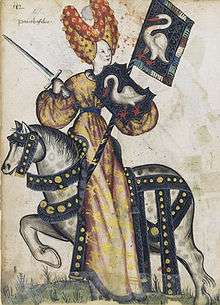
In Medieval Europe the Penthesilea legend was developed and recycled, with Achilles fading into the background. In illuminations that illustrated manuscripts, Penthesilea was cast as medieval warrior queen. A tradition developed where Penthesilea entered the Trojan War because of her reverence for the Trojan hero Hector. Penthesilea appears in the Roman de Troie (1160) by Benoît de Sainte-Maure as a chivalric heroine, and through this became part of the medieval genre roman antique, which recycled Greek and Roman myths in a medieval romance context.
In late medieval Europe the legend was further popularised in Christine de Pizan's City of Ladies (1405) and John Lydgate's Troy Book (1420). Penthesilea and Hector became romantic heroes. Penthesilea came to Troy because she had fallen in love with the virtuous knight Hector from afar.[30] Hector and Penthesilea were portrayed as personifications of the ideals of chivalry. When kneeling before Hector's corpse, Penthesilea promises to avenge his death. Penthesilea fights at the side of the Trojan army, killing many Greek soldiers, but is slain by Achilles' son. In this tradition of the legend, her body is taken to the Thermodon for burial. Along the Terme River various temple burial sites attest to the heroic status Penthesilea had as Amazon queen in the Middle Ages.[31]
In John Gower's Confessio Amanatis she travels to Troy from Pafagoine. She is slain by Pirrus the son of Achilles. Philemenis returned her body for burial. He was rewarded with three fair maidens per year.[30]:iv:2177
Biographical lists of strong women were published, some included Penthesilea. The 1405 Chronicle (known as Haagse handschrift) by the herald Baviere included Penthesilea and the two Amazons Semiramis and Tomyris among the strong women. A Netherlandish list of 101 strong women published between 1465 and 1480 included Penthesilea. This list of 101 women circulated at the court of Mary of Burgundy and was read by members of the Brussels administration. Philippe Bouton in 1480 published a Miroir des dames, which included Penthesilea.[32]
Heinrich von Kleist's Penthesilea
The treatment of Penthesilea that has received most critical attention since the early twentieth century is the drama Penthesilea by Heinrich von Kleist, who cast its "precipitously violent tempo"[33] in the form of twenty-four consecutive scenes without formal breaks into acts. In Kleist's Penthesilea, however, Achilles is slain by Penthesilea. When she realizes that she and her pack of dogs have mangled the object of their desire, she dies herself through "a crushing feeling". The Swiss composer Othmar Schoeck wrote a 90' one-act opera, Penthesilea (Dresden, 1927) based on Kleist's drama. The French composer Pascal Dusapin's opera based on Kleist's work is scheduled to premiere in 2015 at La Monnaie in Brussels under the baton of Ludovic Morlot.[34]
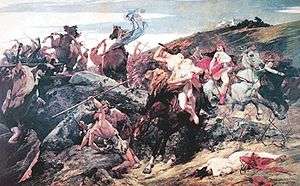
Robert Graves on Penthesilea
In Robert Graves' short poem "Penthesileia", Achilles "for love of that fierce white naked corpse / Necrophily on her" commits,[35] then slays Thersites for his mockery of Achilles' behavior. Graves then has Penthesileia thanking Thersites for his sacrifice in her honour.webopera
Asteroid name
- The asteroid 271 Penthesilea, discovered in 1887, was named in her honor.[36]
Notes
- Lee Fratantuono (2007). Madness Unchained: A Reading of Virgil's Aeneid. Lexington Books. p. 336-337. ISBN 9780739122426.
- José Maria Gutiérrez Arranz (2009). The Cycle of Troy in Geoffrey Chaucer: Tradition and “Moralitee”. Cambridge Scholars Publishing. p. 2. ISBN 9781443815215.
- Barry Strauss (2007). The Trojan War: A New History. Simon and Schuster. p. 160-161. ISBN 9780743264426.
- Barry Strauss (2007). The Trojan War: A New History. Simon and Schuster. p. 162. ISBN 9780743264426.
- Barry Strauss (2007). The Trojan War: A New History. Simon and Schuster. p. 160-161. ISBN 9780743264426.
- Adrienne Mayor (2014). The Amazons: Lives and Legends of Warrior Women across the Ancient World. Princeton University Press. p. 302. ISBN 9781400865130.
- Adrienne Mayor (2014). The Amazons: Lives and Legends of Warrior Women across the Ancient World. Princeton University Press. p. 302. ISBN 9781400865130.
- Frederick A. Cooper & Brian C. Madigan (1992). The Temple of Apollo Bassitas: The sculpture. ASCSA. p. 71. ISBN 9780876619476.CS1 maint: uses authors parameter (link)
- Frederick A. Cooper & Brian C. Madigan (1992). The Temple of Apollo Bassitas: The sculpture. ASCSA. p. 70. ISBN 9780876619476.CS1 maint: uses authors parameter (link)
- Frederick A. Cooper & Brian C. Madigan (1992). The Temple of Apollo Bassitas: The sculpture. ASCSA. p. 72. ISBN 9780876619476.CS1 maint: uses authors parameter (link)
- Adrienne Mayor (2014). The Amazons: Lives and Legends of Warrior Women across the Ancient World. Princeton University Press. p. 300. ISBN 9781400865130.
- Adrienne Mayor (2014). The Amazons: Lives and Legends of Warrior Women across the Ancient World. Princeton University Press. p. 300. ISBN 9781400865130.
- Mary Hamilton Swindler, "The Penthesilea Master" American Journal of Archaeology 19.4 (October 1915), pp. 398–417. In the series Bilder Griechischen Vasen volume 10, edited by Hans Diepolder (1936) is devoted to the Penthesilea-Maler.
- Pseudo-Apollodorus Epitome of the Bibliotheke 5.1 (Sir James George Frazer's translation).
- Adrienne Mayor (2014). The Amazons: Lives and Legends of Warrior Women across the Ancient World. Princeton University Press. p. 303-304. ISBN 9781400865130.
- Magill, Frank N. (2003). The Ancient World: Dictionary of World Biography, Volume 1. Routledge. p. 226. ISBN 1135457409.
- A. M. Keith (2000). Engendering Rome: Women in Latin Epic. Cambridge University Press. p. 68. ISBN 9780521556217.
- Lee Fratantuono (2007). Madness Unchained: A Reading of Virgil's Aeneid. Lexington Books. p. 18-19. ISBN 9780739122426.
- A. M. Keith (2000). Engendering Rome: Women in Latin Epic. Cambridge University Press. p. 66. ISBN 9780521556217.
- Lee Fratantuono (2007). Madness Unchained: A Reading of Virgil's Aeneid. Lexington Books. p. 270. ISBN 9780739122426.
- Adrienne Mayor (2014). The Amazons: Lives and Legends of Warrior Women across the Ancient World. Princeton University Press. p. 303. ISBN 9781400865130.
- Adrienne Mayor (2014). The Amazons: Lives and Legends of Warrior Women across the Ancient World. Princeton University Press. p. 304. ISBN 9781400865130.
- Lee Fratantuono (2007). Madness Unchained: A Reading of Virgil's Aeneid. Lexington Books. p. 336. ISBN 9780739122426.
- Adrienne Mayor (2014). The Amazons: Lives and Legends of Warrior Women across the Ancient World. Princeton University Press. p. 393. ISBN 9781400865130.
- Quintus Smyrnaeus, The Fall of Troy, Book 1
- Jessica Amanda Salmonson (1991). The Encyclopedia of Amazons: Women Warriors from Antiquity to the Modern Era. Paragon House. p. 211. ISBN 9781557784209.
- Virginia Brown (2003). Introduction – Famous Women. Harvard University Press. p. xi. ISBN 9780674011304.
- Giovanni Boccaccio (2003). Famous Women. Harvard University Press. p. 64-65. ISBN 9780674011304.
- Karen Green & Constant Mews (2011). Virtue Ethics for Women 1250–1500. Springer Science & Business Media. p. 149. ISBN 9789400705296.CS1 maint: uses authors parameter (link)
- John Gower (1390). Confession Amantis.:iv:2141
- Adrienne Mayor (2014). The Amazons: Lives and Legends of Warrior Women across the Ancient World. Princeton University Press. p. 302-302. ISBN 9781400865130.
- Karen Green & Constant Mews (2011). Virtue Ethics for Women 1250–1500. Springer Science & Business Media. pp. 180–181. ISBN 9789400705296.CS1 maint: uses authors parameter (link)
- John C. Blankenagel, The Dramas of Heinrich von Kleist: A Biographical and Critical Study (Chapel Hill: University of North Carolina Press) 1931, p 145.
- Thomas May, "Stairway to Heaven: A Major Seattle Symphony Premiere," November 15, 2013, accessed November 15, 2013
- Robert Graves. "Penthesileia". Collected in Selected Poems. Faber & Faber, 2013. ISBN 0571283845. (Google Books)
- Schmadel, Lutz D.; International Astronomical Union (2003). Dictionary of minor planet names. Berlin; New York: Springer-Verlag. p. 39. ISBN 978-3-540-00238-3. Retrieved 9 September 2011.
References
| Wikimedia Commons has media related to Penthesilea. |
- Justinus, Epitome Historiarum philippicarum Pompei Trogi ii.4.31–32
- Epitome of the Philippic History of Pompeius Trogus Book 2
- The audio recording of ElvenQuest, published by BBC Audio in August 2009, ISBN 9781408439241
- Diana Hyppolite, The Exposed Body in Antiquity. Yonkers: Sarah Lawrence College Press, 1984.
| Preceded by Hippolyta |
Queen of the Amazons | Succeeded by Antianara |
